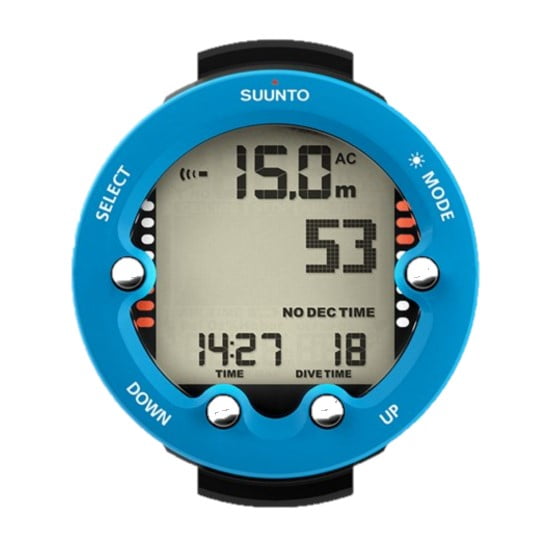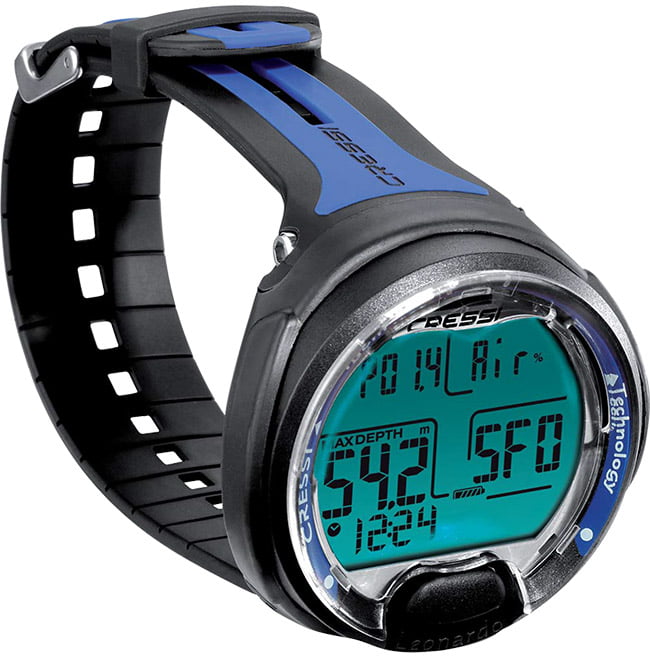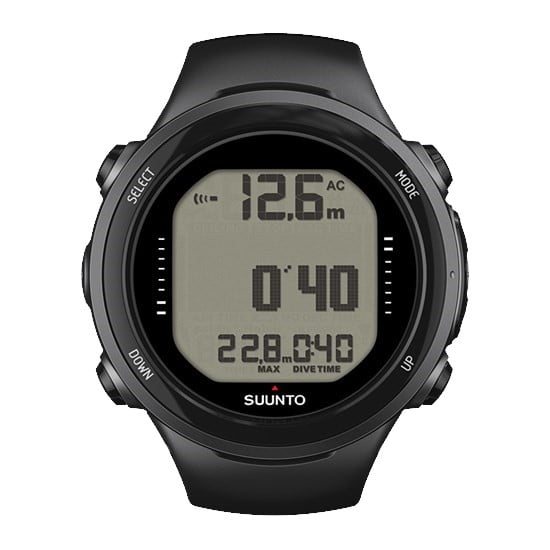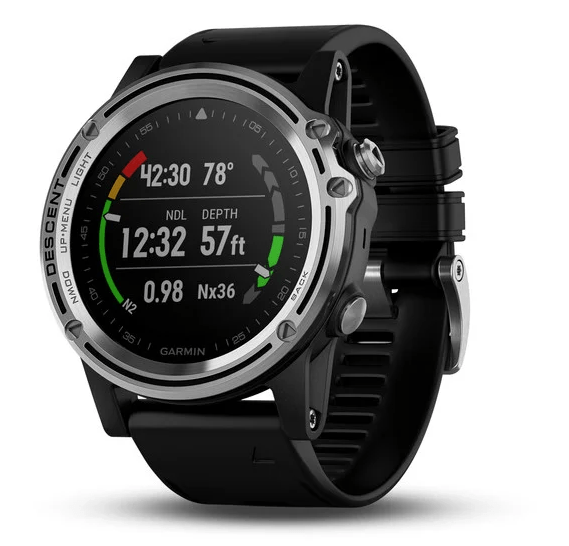So you just got scuba certified and are preparing to make your first major purchase of diving equipment. Dive computers have become an essential piece of dive gear over the past few years as we rely on them at the very least for our no decompression limits and time, but countless other features as well. As the use of recreational dive tables has declined, it has become crucial to find a durable, trustworthy computer. There are so many things to consider, though: depth and dive time, no decompression limits, backlit displays, other various modes, and durability to name a few. Choosing one can be an incredibly daunting task–something with necessary, practical features, something stylish, and a computer that will impress other divers with your purchase.
Ideally, a dive computer should last a few years, if not many more. A little bit of research is required to find one that suits the buyer’s needs and will remain sustainable as technology develops in the coming years. Not to mention, a computer is needed that can provide an entry-level diver with room for growth and exploration into other facets of the diving world. A computer is a diver’s best friend, so choosing the perfect match for you is a must. Not to worry, I have done all the work. Along with my personal experience in dive equipment sales, I present without further ado, the best dive computers for beginning scuba divers.
Best Dive Computers for Beginners Reviewed
#1 Best Dive Watch For Beginners – Suunto Zoop Novo

My top dive computer selection for a beginning diver is the Suunto Zoop Novo. This computer changes the game for beginners, providing you with an easy to use, highly functional computer with a sleek look. Acrylic and a bit bulky, the Zoop Novo has a modest size and trendy appearance–perfect to coordinate with your gear set in the many colors available. It has an iconic feel to it with its super recognizable, brightly colored outer rim. I have sold more of these dive computers than any other to not only just new divers but new dive professionals as well. It is immensely popular for good reason.
Suunto has been around for over 80 years, making dive computers and precision instruments out of Finland. The Zoop Novo is available with most major online dive gear retailers and comes with a price tag of $299. The Zoop Novo is priced on the lower end of the spectrum for dive computers, despite frequently topping best dive computer lists. Budget-friendly computers like the Zoop still possess all the necessary safety features and functions of higher-priced devices.
My favorite things about this computer are its ease of use and potential. This is a dive computer people know and trust, so there will be no “imposter-syndrome” for new divers and no one will question your judgment in this purchase. It is ridiculously easy to operate and has a freedive mode, nitrox mode, and stunning light screen for ventures into night diving. The Suunto Zoop Novo is the perfect fit for someone in search of simplicity or someone looking to branch out from standard diving in the future. It’s a fantastic choice for someone who is unsure about which computer will best suit their needs as a relatively green diver. The Suunto Zoop Novo is the whole package for divers of all backgrounds and levels and will make you look like you came straight out of the Seventies.
Key Features:
- Air, nitrox, gauge, and freediving mode
- Easy to read, high contrast screen
- Maximum depth up to 100 meters
- Continuous decompression algorithm
- Built in Dive Planner
Pros:
- Easy to operate with only 4 buttons
- Potential to venture into Nitrox and Freediving
- Backlit display with adjustable time
- Customization factor (many colors available)
- Very durable with a long-lasting battery
Cons:
- Too bulky, can’t be worn as a wristwatch
- No built-in navigation must use a separate compass
- No air integration capabilities
#2 – Cressi Leonardo

Coming in a close second to the Zoop, the Cressi Leonardo is a budget-friendly, simple to use computer for beginners. It is often debated with the Zoop as the best computer for beginner divers. Available in tons of colors, the Leonardo may just give you the most bang for your buck of all the computers on this list. The Leonardo is small and versatile and can double as a wristwatch–something important to a lot of people that intend to dive frequently or just want to sport the fact that they are a diver. Although I have never personally sold this dive computer, it has been recommended to me countless times. I frequently see new divers sporting this device and rarely hear complaints.
The Leonardo is the first computer ever to be 100% created and produced out of Italy. Cressi put out this high quality beginner computer four years ago and it’s still skyrocketing in popularity. At a bit lower price than the Zoop Novo, this dive computer is available for $199. Started in Genoa, Italy nearly 70 years ago, Cressi is one of the top manufacturers for equipment in diving along with spearfishing, swimming, and snorkeling.
One of the most valuable features of this device is its ability to switch between three conservative modes. As many are aware, one of the most important aspects of being a new diver is making conservative decisions and staying well within your no decompression limits. With the Leonardo’s super audible alarms and three modes, this will never be an issue. As a diving instructor, this is a huge concern for me with new divers. I always encourage extremely conservative decision making and the Leonardo will help you do just that. The compact size means you will never have to take this phenomenal Cressi computer off.
Key Features:
- Nitrox compatible up to 50%
- Depth up to 120 meters
- Compact and durable
- Stopwatch function
- Adjustable altitude function
Pros:
- Conservative level settings
- Single-button navigation
- Potential to venture into Nitrox and freediving
- Small enough to double as a wristwatch in dry times
- Can be completely reset after dives
Cons:
- Not compatible with air integration
- No freediving mode
- No built-in navigation must use a separate compass
- Ascent rate alarms are too loud
- Weak backlight
#3 – Mares Puck Pro Plus

This computer defines simplistic. If you’re a beginner looking for a device with basic functionalities and durability, look no further. This budget-friendly computer comes with a single button design as well and incredibly easy to use. The Puck Pro is also frequently seen in top budget or beginner dive computer lists and for good reason. This stunning little piece of technology flies off the shelf in many dive centers and is a solid first dive computer. It’s ridiculously easy to use, customizable in color and strap, and features multiple modes–what more could you want in your first computer?
The Puck Pro is priced around $179 and comes from Mares, hailing from Italy. Mares is a trustworthy brand that has grown into one of the largest dive equipment manufacturers in the world and is known for merging with the legendary dive manufacturer Dacor. Over 70 years old as well, Mares is now partnered with Scuba Schools International, or SSi, and originally only made masks and spearguns.
One of my biggest impressions of the Puck Pro Plus is the adjustable strap. As unexciting as that sounds, dive computers can be extremely tight on your wrist, especially over a wetsuit, and cut off blood circulation. The Puck has a high adjustable and long enough strap it can fit comfortably over any wetsuit or drysuit without your hand going numb. If you are someone who dives or intends to dive in high frequency, this can become something of very high importance. A computer is only as good as the strap that secures it to your wrist.
Key Features:
- Air, nitrox, gauge, and freediving mode
- Single button navigation
- Log Book can hold 35 hours
- Bottom time mode with average depth and timer
- Depth limit 150 meters
Pros:
- Easy single button navigation
- Potential to venture into Nitrox and freediving
- Slim design
- Very adjustable strap
Cons:
- Strap material is not flexible
- Lacks advanced features
- No built-in navigation
- Not compatible with air integration
- No depth alarm
#4 – Suunto D4i Novo

The D4i is like the Zoop’s more mature older sibling. While still very beginner friendly, this computer is a bit more complex. What stands out immediately when looking at this computer is the significantly more compact size than that of the Zoop, making it a great device to be worn throughout the day. The price of the D4i is a little bit higher, as to be suspected with the increased functionality, however if you want a computer you will continue to use as your experience level reaches closer to intermediate–the D4i is for you. This device is also up there in my top selling computers over the past year. If you are willing to invest a bit more money than in the Zoop, the D4i makes an incredible choice.
Like its sibling computer, the D4i was created and manufactured in Finland by Suunto. Unfortunately the Suunto D4i Novo comes with a higher price tag than the Zoop. In fact, both of these computers come in priced a bit higher than some of their counterparts on this list. Don’t be deterred by spending an extra dime on these guys though, with Suunto you are paying for top quality.
What really sticks out to me about this computer is its lightweight build and durable design. This computer features comfortable silicone straps, strong metal buttons, and will last a new diver quite some time while still maintaining that classic Suunto quality. A dive computer is something we never want to fail us and as a bigger equipment investment, want to replace as infrequently as possible. Eliminate this concern with the D4i Novo.
Key Features:
- Air, nitrox, gauge, and freediving mode
- Continuous RBGM algorithm
- Lightweight and compact
- Conservatism setting
- Adjustable altitude settings
- Apnea timer
Pros:
- Lightweight and compact
- Simple 4 buttons
- Air integration
- Fantastic backlit display
Cons:
- Battery cannot be changed by user
- Tight fit over thick wetsuit or gloves
- No digital compass
- Not many options for customization (colors)
#5 – Garmin Descent MK1

Things get a little more sophisticated with the Garmin MK1. Although this computer sports a much heftier price tag than those previously listed, the MK1 may very well be every new diver’s dream for their first computer. Though Garmin is not traditionally known in the dive equipment industry, they have created a device reminiscent of some of their most successful sport watches and best dive computers on the market. This is a computer I am frequently asked about. Though with any computer there are things to be hesitant about or drawbacks to consider, my recommendation with this device is typically a resounding yes.
Of course with all of its incredible features and versatility, this computer demands a high price: around $990. While this may be alarming at first sight, good dive equipment is an investment. The ocean can be rough and unforgiving, especially on our equipment, and you need to know you can rely on your gear. Although new to the game with dive computers, with this American and Swiss company, you can. Their major export is sport watches, but in recent years they have transitioned into more specialized niches of sports gear and are predicted to be a huge competitor in dive watches down the line.
It’s incredibly difficult to say what pops out the most with this computer. In general, it operates as a dive computer quite similar to one of my favorite brands: Shearwater. However, this gadget is so much more than a dive computer, including a built in smart watch and fitness tracker. This would make the MK1 a strong choice for any athlete looking for a computer that can be used in a multitude of physical activities. One of the other coolest features of this computer has got to be the surface navigation abilities with the built in GPS. There are very few computers on the market offering this kind of technology.
Key Features:
- Recreational, technical and freediving modes
- Built in GPS
- Audible and vibration alerts
- 40 hours of battery life
- 3 axis Compass
- Heart Rate Monitor
- Automatic altitude adjustments
- Safe up to 100 meters
Pros:
- 3-axis underwater compass
- Potential to venture into Nitrox, trimix, apnea and more
- Easily transfer data to your phone
- Purposes beyond diving
Cons:
- Hefty price tag
- Lacks well-made software
- Heart rate sensor prone to cracks
- User interface not as well made as others

Considerations Before Making a Purchase/ Frequently Asked Questions
Is a dive computer a piece of diving equipment a beginner should invest in?
Definitely! Dive computers take the stress and difficulty out of using decompression tables to plan your dives. In recent years, they have become completely necessary to have a safe, conservative dive. This is a piece of equipment every beginner should purchase first. A dive computer gives you everything from your depth reading and dive time to your no decompression limit and ascent rate. They often have built in navigation tools, safety stop timers, safety alarms and notifications, and more. Dive computers have become absolutely essential.
Are dive computers safer than decompression tables?
Yes! Dive computers are constantly working with complex algorithms to consistently deliver you an accurate dive profile and reading on your no decompression limits. With traditional tables, at most we can calculate a multi level dive plan. A computer accounts for all the nuances and small movements of our dive that a table cannot, providing you with an incredibly accurate reading and dive profile. Not only are they safer, but they are easier!
What are the most important features I should look for in my first dive computer?
This is a difficult question. I always stress the need to select a dive that allows you for growth in areas of interest. Do you foresee yourself venturing into nitrox or freediving? Purchase a computer with these commonly available modes. Do you have an interest in night diving? Look for a strong backlit display. Are you planning to dive at a high frequency or as much as possible? Choose a device with a greater log book memory. With that said, basic features like a dive timer, no decompression limits, depth readings, and ascent rate alarms are typical in all computers and are a must.
Should I purchase my computer directly from a shop or online?
As a dive professional this is something I am asked all the time. There is benefit to both. If you know what you want, online might offer you cheaper prices and convenience. However, purchasing in a shop will allow you to sample and see computers, work with a professional to find the best fit from you, and build your relationship with a dive center. There is no reason as a beginner to blindly choose a good looking computer off the internet when you can reach out to the dive community and local shops to help you in a catered selection process. Just beware of shops more interested in pushing a sale than choosing the right dive computer for you.
How much should I spend on my first dive computer?
The amount each individual is willing to spend is up to them. While higher prices may find greater quality and features, there are certainly excellent choices on the lower end of many people’s budget. Expect to find most dive computers in the $200-$1500 range. Even cheaper models include all the necessary safety features. I would not spend an arm and a leg on your first device so you have the opportunity to experiment with different brands and models over the years.